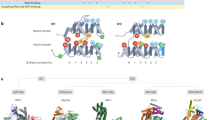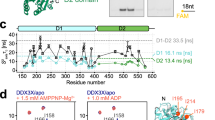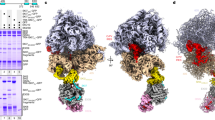Abstract
Members of the DExH/D family of proteins, a subset of helicase superfamily 2 (SF2), are involved in virtually all aspects of RNA metabolism. NPH-II, a prototypical member of this protein family, exhibits robust RNA helicase activity in vitro. Using a series of modified substrates to explore the unwinding mechanism of NPH-II, we observed that the helicase tracks exclusively on the loading strand, where it requires covalent continuity and specifically recognizes the ribose-phosphate backbone. NPH-II unwinding was unaffected by lesions and nicks on the top strand, which has a minimal role in substrate recognition. NPH-II required physical continuity of phosphodiester linkages on the loading strand, although abasic regions were tolerated. These findings suggest that SF2 helicases are mechanistically distinct from other helicase families that can tolerate breaks in the loading strand and for which bases are the primary recognition determinant.
This is a preview of subscription content, access via your institution
Access options
Subscribe to this journal
Receive 12 print issues and online access
$259.00 per year
only $21.58 per issue
Buy this article
- Purchase on SpringerLink
- Instant access to full article PDF
Prices may be subject to local taxes which are calculated during checkout




Similar content being viewed by others
References
de la Cruz, J., Kressler, D. & Linder, P. Unwinding RNA in Saccharomyces cerevisiae: DEAD-box proteins and related families. Trends Biochem. Sci. 24, 192–198 (1999).
Gross, C.H. & Shuman, S. The nucleoside triphosphatase and helicase activities of vaccinia virus NPH-II are essential for virus replication. J. Virol. 72, 4729–4736 (1998).
Grassmann, C.W., Isken, O. & Behrens, S.E. Assignment of the multifunctional NS3 protein of bovine viral diarrhea virus during RNA replication: an in vivo and in vitro study. J. Virol. 73, 9196–9205 (1999).
Fernandez, A. et al. The motif V of plum pox potyvirus CI RNA helicase is involved in NTP hydrolysis and is essential for virus RNA replication. Nucleic Acids Res. 25, 4474–4480 (1997).
Kadare, G. & Haenni, A.L. Virus-encoded RNA helicases. J. Virol. 71, 2583–2590 (1997).
Prince, P.R., Emond, M.J. & Monnat, R.J. Jr. Loss of Werner syndrome protein function promotes aberrant mitotic recombination. Genes Dev. 15, 933–938 (2001).
Caruthers, J.M., Johnson, E.R. & McKay, D.B. Crystal structure of yeast initiation factor 4A, a DEAD-box RNA helicase. Proc. Natl. Acad. Sci. USA 97, 13080–13085 (2000).
Lorsch, J.R. & Herschlag, D. The DEAD box protein eIF4A. 2. A cycle of nucleotide and RNA-dependent conformational changes. Biochemistry 37, 2194–2206 (1998).
Lorsch, J.R. & Herschlag, D. The DEAD box protein eIF4A. 1. A minimal kinetic and thermodynamic framework reveals coupled binding of RNA and nucleotide. Biochemistry 37, 2180–2193 (1998).
Rogers, G.W. Jr., Komar, A.A. & Merrick, W.C. eIF4A: the godfather of the DEAD box helicases. Prog. Nucleic Acid Res. Mol. Biol. 72, 307–331 (2002).
Boddeker, N., Stade, K. & Franceschi, F. Characterization of DbpA, an Escherichia coli DEAD box protein with ATP independent RNA unwinding activity. Nucleic Acids Res. 25, 537–545 (1997).
Diges, C.M. & Uhlenbeck, O.C. Escherichia coli DbpA is an RNA helicase that requires hairpin 92 of 23S rRNA. EMBO J. 20, 5503–5512 (2001).
Henn, A. et al. Visualization of unwinding activity of duplex RNA by DbpA, a DEAD box helicase, at single-molecule resolution by atomic force microscopy. Proc. Natl. Acad. Sci. USA 98, 5007–5012 (2001).
Nicol, S.M. & Fuller-Pace, F.V. The 'DEAD box' protein DbpA interacts specifically with the peptidyltransferase center in 23S rRNA. Proc. Natl. Acad. Sci. USA 92, 11681–11685 (1995).
Schwer, B. & Guthrie, C. Prp16 is an RNA-dependent ATPase that interacts transiently with the spliceosome. Nature 349, 494–499 (1991).
Bartenschlager, R. & Lohmann, V. Replication of hepatitis C virus. J. Gen. Virol. 81, 1631–1648 (2000).
Lam, A.M., Keeney, D., Eckert, P.Q. & Frick, D.N. Hepatitis C virus NS3 ATPases/helicases from different genotypes exhibit variations in enzymatic properties. J. Virol. 77, 3950–3961 (2003).
Tsu, C.A. & Uhlenbeck, O.C. Kinetic analysis of the RNA-dependent adenosinetriphosphatase activity of DbpA, an Escherichia coli DEAD protein specific for 23S ribosomal RNA. Biochemistry 37, 16989–16996 (1998).
Jankowsky, E., Gross, C.H., Shuman, S. & Pyle, A.M. The DExH protein NPH-II is a processive and directional motor for unwinding RNA. Nature 403, 447–451 (2000).
Pang, P.S., Jankowsky, E., Planet, P.J. & Pyle, A.M. The hepatitis C viral NS3 protein is a processive DNA helicase with cofactor enhanced RNA unwinding. EMBO J. 21, 1168–1176 (2002).
Gorbalenya, A. & Koonin, E.V. Helicases: amino acid sequence comparisons. Curr. Opin. Struct. Biol. 3, 419–429 (1993).
Shuman, S. Vaccinia virus RNA helicase: an essential enzyme related to the DE-H family of RNA-dependent NTPases. Proc. Natl. Acad. Sci. USA 89, 10935–10939 (1992).
Gross, C.H. & Shuman, S. Vaccinia virus RNA helicase: nucleic acid specificity in duplex unwinding. J. Virol. 70, 2615–2619 (1996).
Jankowsky, E., Gross, C.H., Shuman, S. & Pyle, A.M. Active disruption of an RNA-protein interaction by a DExH/D RNA helicase. Science 291, 121–125 (2001).
Bianco, P.R. & Kowalczykowski, S.C. Translocation step size and mechanism of the RecBC DNA helicase. Nature 405, 368–372 (2000).
Amaratunga, M. & Lohman, T.M. Escherichia coli rep helicase unwinds DNA by an active mechanism. Biochemistry 32, 6815–6820 (1993).
Honig, A., Auboeuf, D., Parker, M.M., O'Malley, B.W. & Berget, S.M. Regulation of alternative splicing by the ATP-dependent DEAD-box RNA helicase p72. Mol. Cell Biol. 22, 5698–5707 (2002).
Bertram, R.D., Hayes, C.J. & Soultanas, P. Vinylphosphonate internucleotide linkages inhibit the activity of PcrA DNA helicase. Biochemistry 41, 7725–7731 (2002).
Velankar, S.S., Soultanas, P., Dillingham, M.S., Subramanya, H.S. & Wigley, D.B. Crystal structures of complexes of PcrA DNA helicase with a DNA substrate indicate an inchworm mechanism. Cell 97, 75–84 (1999).
Dillingham, M.S., Soultanas, P., Wiley, P., Webb, M.R. & Wigley, D.B. Defining the roles of individual residues in the single-stranded DNA binding site of PcrA helicase. Proc. Natl. Acad. Sci. USA 98, 8381–8387 (2001).
Korolev, S., Hsieh, J., Gauss, G.H., Lohman, T.M. & Waksman, G. Major domain swiveling revealed by the crystal structures of complexes of E. coli Rep helicase bound to single-stranded DNA and ADP. Cell 90, 635–647 (1997).
Seybert, A., Scott, D.J., Scaife, S., Singleton, M.R. & Wigley, D.B. Biochemical characterisation of the clamp/clamp loader proteins from the euryarchaeon Archaeoglobus fulgidus. Nucleic Acids Res. 30, 4329–4338 (2002).
Singleton, M.R. & Wigley, D.B. Modularity and specialization in superfamily 1 and 2 helicases. J. Bacteriol. 184, 1819–1826 (2002).
Kim, J.L. et al. Hepatitis C virus NS3 RNA helicase domain with a bound oligonucleotide: the crystal structure provides insights into the mode of unwinding. Structure Fold Des. 6, 89–100 (1998).
Wincott, F. et al. Synthesis, deprotection, analysis and purification of RNA and ribozymes. Nucleic Acids Res. 23, 2677–2684 (1995).
Jankowsky, E. & Schwenzer, B. Efficient improvement of hammerhead ribozyme mediated cleavage of long substrates by oligonucleotide facilitators. Biochemistry 35, 15313–15321 (1996).
Shoemaker, D.P., Garland, C.W., Steinfeld, J.I. & Nibler, J.W. Treatment of experimental data. In Experiments in Physical Chemistry Vol. 1 (eds. Provenzano, M.D. & Amerman, S.) 25–52 (McGraw Hill, New York, 1981).
Acknowledgements
We thank Q. Yang (Case Western Reserve University) for his kind help with the experiments shown in Figure 2. We also thank the members of the Pyle lab, particularly O. Fedorova, C. Duarte, A. deLencastre and V. Serebrov, for many insightful discussions and O. Fedorova for the synthesis of oligonucleotides containing abasic clusters. We thank S. Shuman (Sloan-Kettering Institute) and C. Gross (Vertex Pharmaceuticals) for NPH-II plasmids and baculovirus constructs, protein expression protocols and many thoughtful discussions. We credit D. Wigley for the term “molecular wire stripper,” which he has used in lectures, and which we cite with his permission. We also thank S. Lomvardas (Columbia University) for help with protein expression and purification and for helpful discussions. This work was supported by a grant from the US National Institutes of Health (GMRO1 60620 to A.M.P.). A.M.P. is an investigator of the Howard Hughes Medical Institute.
Author information
Authors and Affiliations
Corresponding author
Ethics declarations
Competing interests
The authors declare no competing financial interests.
Supplementary information
Rights and permissions
About this article
Cite this article
Kawaoka, J., Jankowsky, E. & Pyle, A. Backbone tracking by the SF2 helicase NPH-II. Nat Struct Mol Biol 11, 526–530 (2004). https://doi.org/10.1038/nsmb771
Received:
Accepted:
Published:
Issue date:
DOI: https://doi.org/10.1038/nsmb771
This article is cited by
-
The RNA helicase Mtr4p is a duplex-sensing translocase
Nature Chemical Biology (2017)
-
Substrate interactions and promiscuity in a viral DNA packaging motor
Nature (2009)
-
Chromatin remodeling: insights and intrigue from single-molecule studies
Nature Structural & Molecular Biology (2007)
-
Intermediates revealed in the kinetic mechanism for DNA unwinding by a monomeric helicase
Nature Structural & Molecular Biology (2006)
-
When a helicase is not a helicase: dsDNA tracking by the motor protein EcoR124I
The EMBO Journal (2006)



